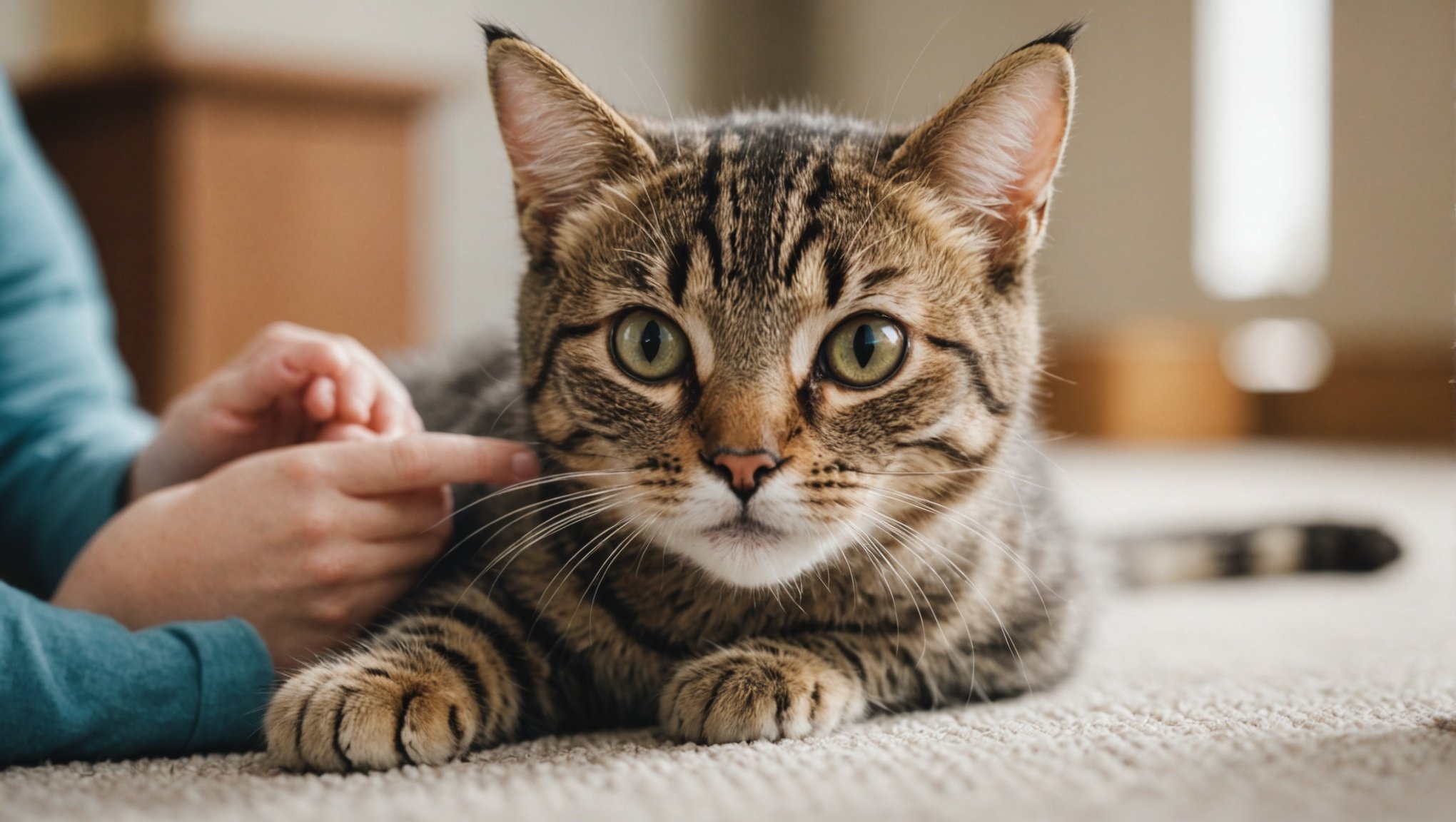Welcoming a new baby brings joy and excitement, but it can also be a challenge for your feline friend. Cats thrive on routine and may feel stressed by the changes within their environment. Understanding your cat’s emotional needs is essential to ensuring a smooth transition. This guide offers practical tips to help your cat adjust, reducing anxiety and fostering a peaceful relationship with your new addition. Prepare your home and your pets for this exciting new chapter together.
Preparing Your Cat for the New Arrival
When expecting a new baby, it’s essential to focus on cat preparation for baby. Cats are creatures of habit and can be sensitive to changes in their environment. Understanding feline behavior changes is crucial in ensuring a smooth transition. Cats may exhibit signs of stress, such as increased hiding or vocalization, when they sense something is different. Recognizing these behaviors early can help you address them effectively.
Lire également : Essential Tips for Caring for Your Cat”s Whiskers: Enhancing Their Sensory Health
Creating a safe space for your cat is another vital step. This area should be free from disturbances, providing a sanctuary where your cat can retreat when feeling overwhelmed. Equip this space with familiar items like their bed, toys, and a scratching post to make it comforting.
Gradual introduction techniques can ease your cat’s adaptation to the new family member. Start by letting your cat explore baby-related items, like the crib or stroller, before the baby arrives. This helps reduce anxiety by familiarizing them with new scents and objects. Once the baby is home, allow your cat to observe from a distance, gradually decreasing the space between them as they become more comfortable.
En parallèle : Understanding Feline Urination Issues: Effective Solutions and Potential Causes for Inappropriate Behavior
By preparing your cat thoughtfully, you can foster a harmonious environment for both your pet and your new arrival.
Behavioral Adjustments for Cats
When preparing for a new baby, effective cat behavior management is crucial. Cats, being sensitive creatures, often show signs of stress when their environment changes. Identifying these signs early is essential. Look for behaviors such as excessive grooming, increased vocalization, or withdrawal. Recognizing these can help you take timely action.
Implementing a consistent routine before the baby arrives can significantly ease this transition. Cats thrive on predictability, so maintaining regular feeding, play, and rest times can provide comfort and stability. This routine helps your cat feel secure, even as other aspects of the household change.
Positive reinforcement strategies can also be beneficial. Reward your cat with treats or affection when they display calm and relaxed behavior around baby-related items. This approach encourages positive associations with the new elements in their environment.
Incorporating these techniques can make a significant difference in how your cat adapts to the upcoming changes. By focusing on cat behavior management and understanding their needs, you can create a peaceful and harmonious home for both your cat and your new baby.
Gradual Introduction of Baby and Cat
Introducing a new baby to your cat requires patience and strategy. Ensuring that introducing baby to cat is a positive experience will help foster a peaceful coexistence.
First interactions
Begin by letting your cat observe the baby from a distance. This initial exposure allows your cat to become accustomed to the new presence without feeling threatened. During these first interactions, monitor your cat’s body language closely for signs of stress or curiosity. Look for relaxed postures, such as a softly swishing tail or gentle purring, which indicate comfort.
Supervised meetings
As your cat becomes more comfortable, gradually decrease the distance between them and the baby. Always supervise these meetings to ensure safety for both your cat and the baby. Encourage gentle behaviour by speaking softly and offering treats when your cat remains calm. This supervision helps prevent any sudden movements that might startle your cat.
Building positive associations
To create a harmonious relationship, focus on building positive associations between your cat and the baby. Offer your cat treats or affection when they are calm around the baby. This reinforcement encourages your cat to associate the baby with positive experiences. Over time, these positive interactions will help your cat feel more at ease with the new family member, promoting a peaceful environment.
Creating a Positive Home Environment
Ensuring a safe environment for cats is essential when introducing a new baby. Start by designating specific areas in the home where your cat can feel secure. These spaces should be equipped with familiar items like their bed and toys, providing a comforting retreat.
Designating Areas for Comfort
Create zones where your cat can escape the hustle and bustle of a busy household. These areas should be quiet and away from high-traffic locations. This helps your cat maintain a sense of territory and reduces anxiety.
Using Calming Products
Consider using calming products or pheromones to help your cat adjust. Products like pheromone diffusers mimic natural cat scents, promoting relaxation. These can be particularly effective in reducing stress and encouraging calm behaviour.
Maintaining Cleanliness
A clean environment is crucial for a stress-free home. Regularly clean litter boxes and ensure feeding areas are tidy. This not only keeps your cat healthy but also helps in reducing stress levels.
By focusing on these aspects, you can create a harmonious living space that supports both your cat’s well-being and the new family dynamic.
Addressing Potential Challenges
Introducing a new baby to a household can present several cat challenges with baby. Cats may experience jealousy or anxiety due to the sudden shift in attention and routine. Recognizing these potential issues early is crucial to ensuring a smooth transition.
Common Issues
Cats may display behaviours such as increased aggression, withdrawal, or inappropriate urination. These are often signs of stress or jealousy. Such behaviours can disrupt the household and affect the well-being of both the cat and the baby.
Mitigating Jealousy and Anxiety
To address these challenges, consider implementing strategies to reduce your cat’s anxiety. Gradual changes to their environment, maintaining a consistent routine, and providing extra affection can help. Additionally, using calming products can aid in reducing stress levels.
Consulting Professionals
If behavioural issues persist, consulting with veterinarians or animal behaviourists can provide valuable insights. These professionals can offer tailored advice and solutions to address specific concerns. They might suggest behaviour modification techniques or recommend products that can aid in calming your cat.
By proactively addressing cat challenges with baby, you can foster a harmonious environment, ensuring the well-being of both your pet and your new family member.
Expert Insights on Cat and Baby Dynamics
Navigating the dynamics between cats and babies can be challenging, but expert advice can provide invaluable guidance. Interviews with veterinarians and animal behaviorists reveal that understanding feline psychology is crucial. They emphasize the importance of maintaining a consistent routine and creating safe spaces for cats to reduce stress during this transition.
Case Studies of Successful Integrations
Case studies highlight successful integrations where families have harmoniously introduced a new baby into a cat-friendly home. In one instance, a family gradually introduced their cat to the baby’s scent by using items like blankets. This method helped the cat associate the new scent with positive experiences, reducing anxiety over time.
Tips from Experienced Cat Owners
Experienced cat owners recommend several practical tips. They suggest using calming products, such as pheromone diffusers, to ease the cat’s stress. Additionally, engaging in interactive play sessions can help redirect any negative energy and reinforce positive behavior.
Veterinarians often advise patience and gradual exposure as essential strategies. They stress that every cat is unique, and what works for one may not work for another. By combining expert insights with real-life experiences, you can create a harmonious environment that caters to both your cat’s needs and your growing family.
Personal Anecdotes and Experiences
Real-life experiences offer valuable insights into successfully integrating cats and babies. Many families have shared their stories, highlighting both challenges and triumphs.
Stories from Families
One family, for instance, found that their cat initially showed signs of stress when the baby arrived. By gradually introducing the baby’s scent through blankets and clothing, the cat became more comfortable. Over time, the cat began to associate these scents with positive experiences, such as playtime and treats, easing the transition.
Lessons Learned
Families report that patience and consistency are crucial. Maintaining a familiar routine for the cat, even amidst changes, helps reduce anxiety. Many have learned that allowing the cat to approach the baby at its own pace fosters a sense of security and trust.
Heartwarming Outcomes
The bond that can develop between cats and babies is often heartwarming. In one case, a cat became the baby’s constant companion, often found napping beside the crib. Such relationships not only enrich the household dynamic but also provide comfort and joy to both the pet and the child.
These anecdotes underscore the importance of understanding and respecting each cat’s unique personality during this significant transition.
Resources for Cat Owners
Navigating the journey of introducing a baby to a household with a cat can be simplified with the right cat owner resources. These resources offer valuable insights and support for ensuring a harmonious environment.
Recommended Books and Articles
Books and articles tailored for cat owners are a treasure trove of information. Titles such as “Cat vs. Baby: A Peaceful Coexistence” provide comprehensive guides on preparing your feline friend for a new family member. Articles in pet magazines also offer expert advice on managing this transition smoothly.
Online Forums and Support Groups
Online forums and support groups are excellent platforms for sharing experiences and seeking advice. Websites like The Cat Site and Reddit’s r/CatAdvice community connect cat owners worldwide. These platforms allow you to ask questions and receive answers based on real-life experiences, which can be invaluable for resolving specific concerns.
Local Pet Organizations and Services
Local pet organizations often host workshops and seminars on cat behavior and care. These events can be a great opportunity to learn from professionals and other cat owners. Additionally, services such as pet behaviorists and trainers can offer personalized advice tailored to your cat’s needs.
Utilizing these resources can empower cat owners to make informed decisions, fostering a positive environment for both pets and family members.
Maintaining Cat Care After the Baby Arrives
Balancing ongoing cat care with baby responsibilities is crucial for a harmonious household. As your family grows, it’s important to adjust routines to accommodate both your cat and the new baby.
Adjusting Routines Post-Baby Arrival
The arrival of a baby often disrupts household routines. To maintain stability, gradually adapt your cat’s schedule. Ensure feeding times remain consistent, which helps your cat feel secure amid changes. Integrate play sessions into your daily routine to provide your cat with the attention they need.
Ensuring Continued Attention for Your Cat
With a new baby, it’s easy for pets to feel neglected. Dedicate specific times each day to focus solely on your cat. This could be through grooming, cuddling, or interactive play. Consistent attention reassures your cat of their place in the family, reducing feelings of jealousy or anxiety.
Monitoring Cat Behavior as the Baby Grows
As the baby develops, their interactions with your cat will change. Monitor your cat’s behavior closely for signs of stress or discomfort. Look for indications such as hiding or changes in eating habits. Being vigilant allows you to address any issues promptly, ensuring both your cat and baby coexist peacefully.
















